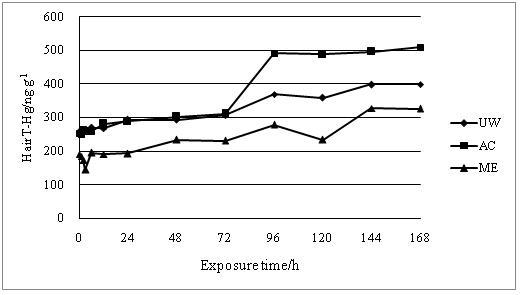Research group led by Professor FENG Xinbin in the State Key Laboratory of Environmental Geochemistry (SKLEG) at Institute of Geochemistry, Chinese Academy of Sciences (IGCAS) has recently made new progress in the biomarker of occupational exposure to mercury vapor. It concluded that hair could be a useful tool for monitoring occupational exposure to mercury vapor.
 |
| Fig. Hair T-Hg concentrations with different washing procedures for different exposed times (Image by IGCAS) |
In general, urine mercury (U-Hg) is commonly used for the assessment of inorganic mercury (I-Hg) exposure in humans, while human hair and blood are usually used as biological indicators for estimating methylmercury (Me-Hg) exposure. Hair has several advantages as a biomarker: it can be obtained by non-invasive sampling, it is easy for storage, and it contains higher concentrations of elements (compared to urine and blood specimen). In addition, segmental analyses of hair mercury (Hg) can trace dynamic change of exposure over hair growing period, since hair growth rate is generally estimated at 1 cm/month.
However, the reliability of human scalp hair as an indicator of mercury vapor exposure is contentious. The key issues to be solved are quantification of the contributions from different exposure sources and elimination of the exogenous contaminations. Therefore, the study by Professor FENG Xinbin’s group was designed to: (1) quantify the contribution of direct absorption/adsorption of Hg vapor in the hair by simulated experiments and different washing styles; (2) evaluate the possibility of hair as a biomarker of exposure to Hg vapor for occupational population.
Their previous study has confirmed significant correlations between hair total mercury (T-Hg) and U-Hg and between hair I-Hg and total gaseous mercury (TGM) in ambient air. In their current study, simulated experiments were designed to assess the contribution of direct absorption/adsorption of mercury vapor in the hair. The results indicated that the direct absorption/adsorption of Hg vapor in hair was negligible compared with hair I-Hg in occupationally exposed workers. The washing styles had significant effects on hair Hg concentrations, e.g. the β-mercaptoethanol washing could remove 30% of Hg in the exposed hair samples. Both the simulated experiments and field data analysis led to the conclusion that hair I-Hg could be a useful tool for monitoring occupational exposure to Hg vapor.
The above research achievements have been published in《Science of the Total Environment》(2011, 409: 4484-4488).
(ByLI Ping, Edited by XIAO Yi)